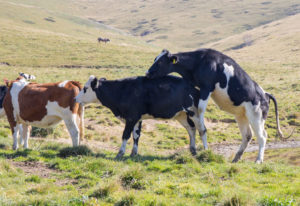Bull Fertility Testing

The main serving period for spring calving herds is rapidly approaching. It is therefore a great time to think about the fitness of your bulls for breeding.
A tight calving period carries many advantages to a herd including easier management of cows in the run up to and during calving and easier
management of the offspring as they will be of a more similar age and size. This generally results in calves of a greater size at the point of sale as well as reduced losses leading to an increase in herd profitability.
In order to achieve a tight calving period, the mating period must be well managed. There are several cow factors that can lead to reduced fertility, however one major cause of reduced herd fertility is a poorly performing bull. It is very uncommon for a bull to be totally infertile, however it is more common for a bull to be sub fertile, meaning a lower percentage of cows will hold in calf to first service.
Castle Farm Vets are able to offer a bull fertility testing service. This includes a full physical examination of the bull including measurement of the testes followed by collection of a semen sample by electro ejaculation. This sample is then examined under the microscope to assess the quality and activity of the sperm. We are then able to give an accurate assessment of the bull’s suitability for work in the coming season.
Special offer
No visit fee for bull fertility testing and pelvis scoring visits in May and June 2021 Please call any of our branches to book in:
Barnard Castle – 01833 695695
Malton – 01653 531151
Darlington – 01325 790713

Heifer Pelvic Measurement
It is logical that there is a strong correlation between the area of the pelvic opening of a heifer and ease of which she will calve. Therefore by removing heifers with poor pelvic size from your herd before breeding you can dramatically reduce the number of assisted calving’s and associated calf losses you experience.
The procedure to measure the pelvis is very well tolerated and quick to perform. A pair of blunt callipers are inserted rectally allowing the vertical height and horizontal width of the pelvis to be measured, these figures are then multiplied together to give an overall area. This final figure can then be compare with the expected figure for an animal of that age.
In our experience 1 in 10 animals are either small or marginal, therefore may not be retained for breeding. We have also found that how tall/ well grown a heifer is does not always correlate with the pelvic area.
Whilst measuring the pelvis we are also able to perform a pre-breeding check to ensure that the animal is cycling and does not have any reproductive abnormalities such as freemartinism. All this combined with your bull fertility test allows you to put your heifers to the bull with confidence and achieve high live calf percentages within a tight calving period.
